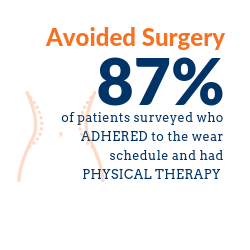Treating Scoliosis and Avoiding Surgery
Scoliosis affects an estimated 6-9 million people in the United States, and every year about 3 million new cases of scoliosis are diagnosed. While there are several different kinds of scoliosis, the majority of cases are idiopathic adolescent scoliosis, which affects children and adolescents aged 10-18. Spinal curves that are greater than 25 degrees may require treatment.
Scoliosis Treatment Options
When a spinal curve is detected, the doctor will make a treatment recommendation based on the patient's age, how much more he or she is likely to grow, and the degree and location of the curve.
Recommendations include:
- Observation: Usually recommended in cases when the patient is still growing and has a spinal curve of less than 25 degrees.
- Physical Therapy: Doctors may prescribe specific scoliosis exercises to manage symptoms, improve posture, and maximize range of movement, either alone or as part of bracing.
- Bracing: If the patient is still growing and has an idiopathic curve of more than 25-30 degrees, the doctor may recommend wearing a scoliosis brace to stop the curve from getting any worse.
- Surgery: In extreme cases, the doctor may recommend spinal surgery.
When Is Surgery Required for Scoliosis?
Surgery may be recommended if the patient is still growing and has a spinal curve greater than 45-50 degrees that is getting worse.
An estimated 5-10% of diagnosed scoliosis cases will need surgery, and 38,000 patients undergo spinal fusion surgery in the United States every year.
There are two types of scoliosis surgery—open surgery and minimally invasive surgery. Open surgery is the more traditional surgery type, where the back is opened up to give the surgeon access to the spine. With minimally invasive scoliosis surgery, the surgeon will make small incisions along the back and insert a tool that is used to attach rods and screws to the spine.
While spinal fusion surgery is the only scoliosis treatment that can straighten the spine, there are many things to consider before deciding whether surgery is the right option. Like all surgery, spinal fusion surgery carries risks. The surgery usually requires general anesthesia, and can cause muscle and nerve damage, excess bleeding, blood clots, infection, and osteoarthritis.
While post-surgery pain should ease after a few days or weeks, full recovery can take up to a year and there are many reports of persistent or chronic pain from scoliosis surgery, even many years later. In some cases, additional spinal surgery is required.
To get more information on scoliosis surgery you can visit the Scoliosis Research Society.
Non-Surgical Scoliosis Treatment
Results Based Long-term Study
 In 2017, we reviewed our scoliosis patients fit with an authentic Boston Brace made by Boston O&P between 2005-2012. Over 3,500 letters were mailed to patients who were out of their brace for more than five years. 334 patients responded to our questionnaire. According to this long-term patient satisfaction survey, of the patients treated with the authentic Boston Brace, 78.9% did not undergo scoliosis surgery. Better yet, 86.8% of bracing patients who adhered to the wearing schedule and also had physical therapy did not need spinal surgery. Conversely, those patients who did not adhere to the wearing schedule, 32.1% had spinal surgery, and 44% of those who were non-compliant with the wear schedule and did not have physical therapy eventually had spinal surgery.
In 2017, we reviewed our scoliosis patients fit with an authentic Boston Brace made by Boston O&P between 2005-2012. Over 3,500 letters were mailed to patients who were out of their brace for more than five years. 334 patients responded to our questionnaire. According to this long-term patient satisfaction survey, of the patients treated with the authentic Boston Brace, 78.9% did not undergo scoliosis surgery. Better yet, 86.8% of bracing patients who adhered to the wearing schedule and also had physical therapy did not need spinal surgery. Conversely, those patients who did not adhere to the wearing schedule, 32.1% had spinal surgery, and 44% of those who were non-compliant with the wear schedule and did not have physical therapy eventually had spinal surgery.
While bracing itself has shown excellent outcomes for scoliosis, adherence to the wear schedule and receiving physical therapy are also important factors in the success of the treatment and the avoidance of spinal surgery.
The study also provided insights from the 32.1% of patients who reported non-adherence. Some said the brace was uncomfortable; some said the brace interfered with recreational activities (sports, dance, theater); and others said the brace was too hot. While we can't address every concern, we have addressed the number one concern and are now producing our new and innovative Boston Brace 3D®, which is far more comfortable than older versions of the Boston Brace.
Many reported it was a positive experience with quotes including, "Overall, I had a positive brace experience—thank you for the research, " and, "I hated wearing my brace, but it definitely helped with my back pain and posture. I'm so glad I wore it".
See the Boston O&P patient satisfaction presentation.
Ultimately, the decision of which scoliosis treatment option to pursue depends on a number of objective factors and personal preferences. Consult with your clinician and doctor about your specific case.

